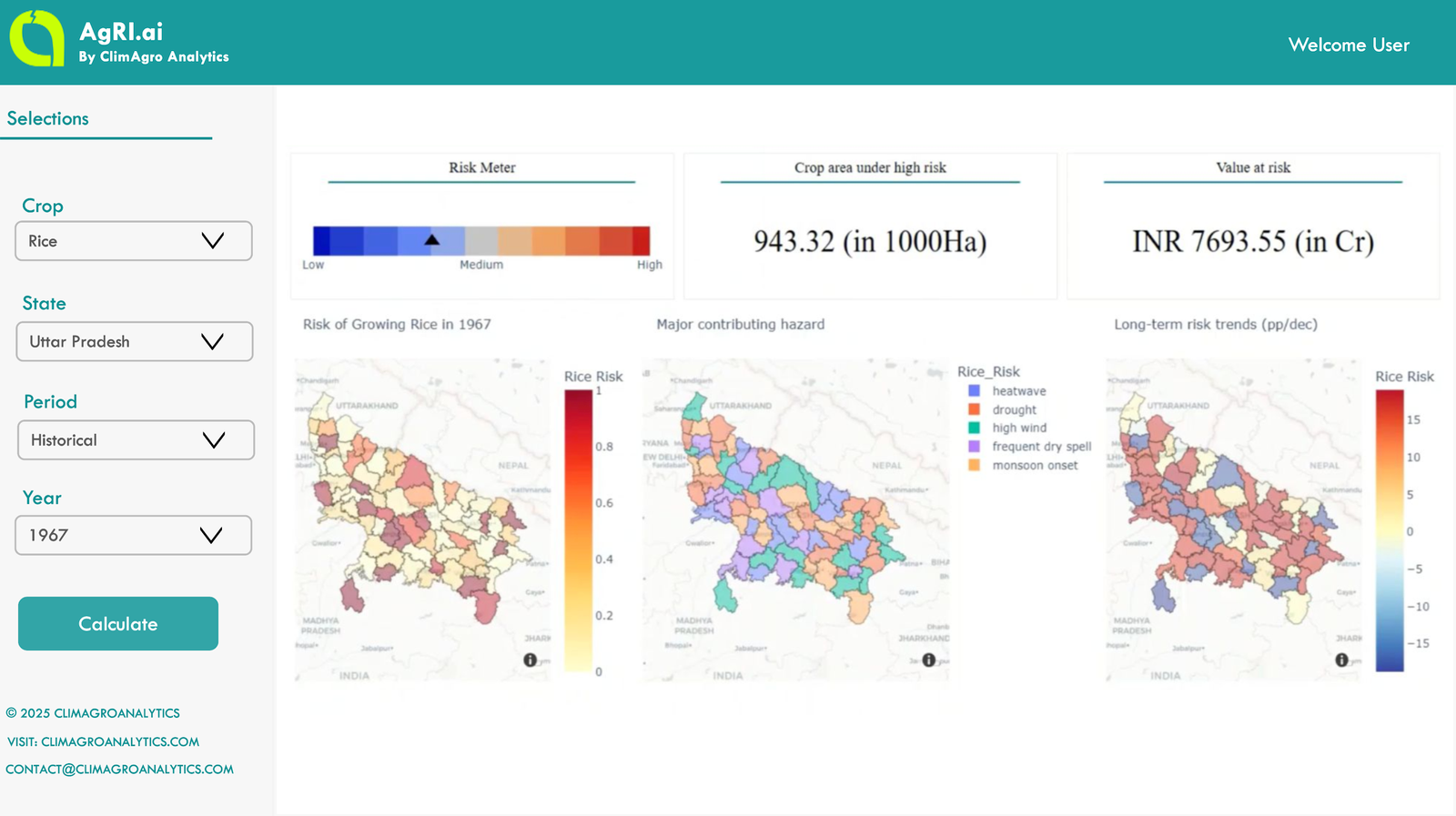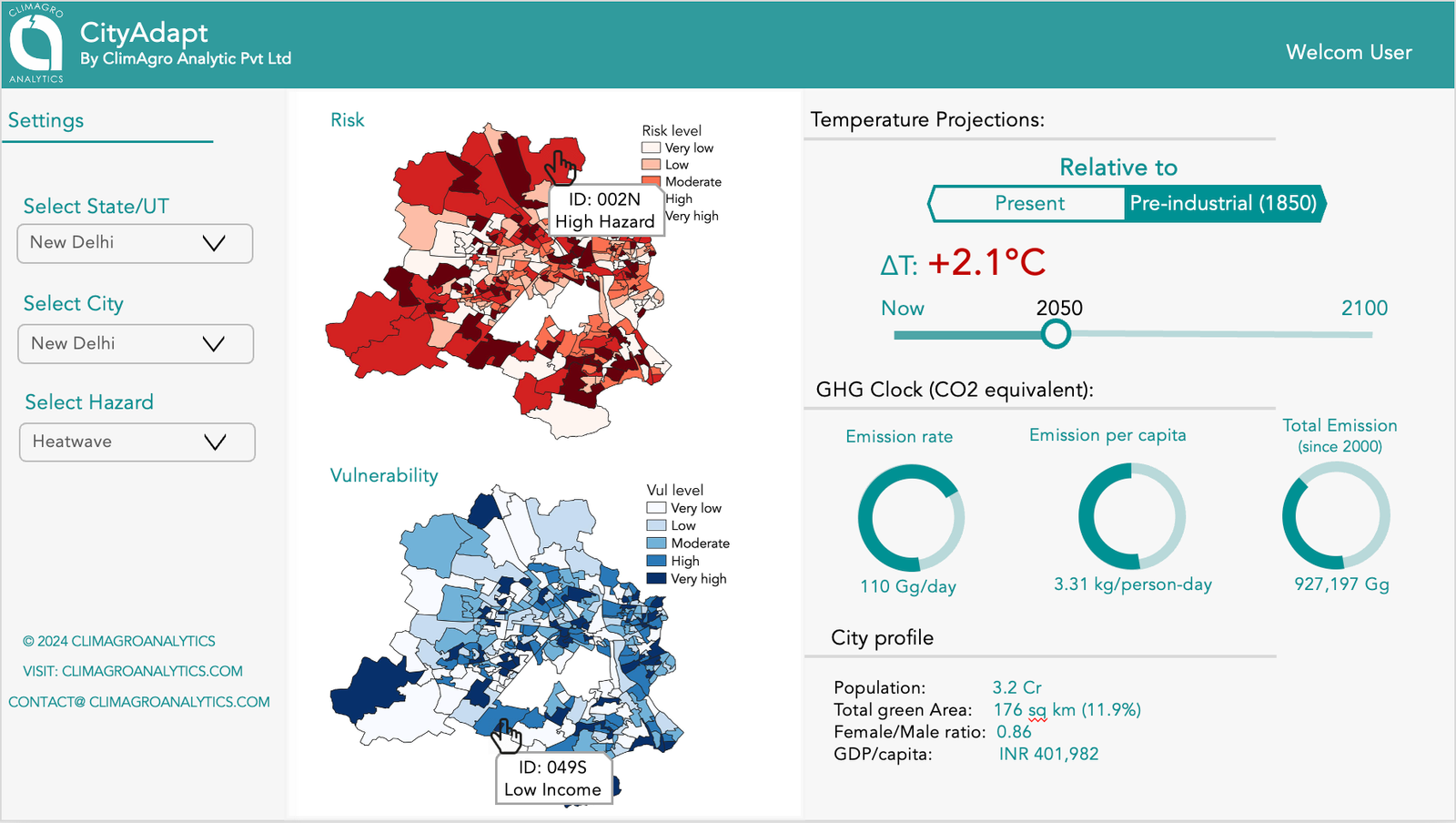
LATEST BLOG POSTS AND UPDATES
Discover our latest thoughts, tutorials, and insights on technology, innovation, and industry trends.
ClimAgro leverages AI-powered, research-backed models to assess climate risks in agriculture and allied sectors. We provide insights on current and future risks to help stakeholders anticipate challenges, make informed decisions, optimize resources, and build resilience.
Explore our core solutions designed to drive climate resilience and intelligence for forward-thinking organizations.

AgRI.ai is a crop-location-specific risk estimator that uses AI and machine learning to analyze crop-climate interactions through historical data.

Helps cities assess ward-level risks and prepare for climate adaptation with deep data insights, risk hotspot identification, and future warming projections.

Access multi-resolution climate data tailored for vulnerable regions with hazard maps for heatwaves, floods, droughts, and multi-level risk intelligence.

Strategic consulting services supporting climate risk planning for governments, NGOs, and enterprises with custom assessments and adaptation strategies
We work with companies across a wide range of industries to build end-to-end climate resilience,
from research and development to operations and supply chain.
ClimAgro equips institutions with yield predictions and risk insights for better loan and insurance decisions.
Optimize your supply chain with pre-harvest insights, efficient logistics, and planning support.
Stay ahead with insights that help optimize logistics and planning, ensuring smooth supply chain operations.
Transform agricultural governance with data-driven insights that aid in strategic planning and risk mitigation.
Support seed development with climate-smart insights for planting windows and yield predictions.
Help industries integrate sustainability and resilience into strategic business operations and ESG goals.

Discover our latest thoughts, tutorials, and insights on technology, innovation, and industry trends.

Deep dive into market research, user behavior analysis, and strategic business intelligence.

Comprehensive articles covering industry expertise, case studies, and thought leadership content.
By 2050, India is expected to witness an approximately 50 % increase in food demand, with an increasing climate risk (IPCC, 2021). The scientific community identifies weather-induced losses as a significant contributing factor to low-yields observed in India. According to scientific literature, a 2°C increase in global mean temperature is associated with significant crop yield reductions: corn by 31%, rice by 19%, and wheat by 46%. It is noteworthy that agriculture, being the second-largest contributor to global emissions, plays a crucial role in shaping climate change impacts on food production. In India, 55 of the cropped area is rain-fed. In addition to that, in the vulnerability analysis conducted by the ministry of agriculture & Farmer welfare, Govt of India in 2021, 109 districts out of 573 rural districts 19 of total districts are very high-risk districts, while 201 districts are risk districts.
World Economic Forum survey of 1490 leaders: Extreme weather affects yields and economy. India ranks 7th in climate risk. By 2050, population hits 1.73bn, demanding 70% more food. 61% of farmers rely on rain for ~55% of crops, which will lead to ~70% increase in food demand.
A. Climate Financial Scenario Analysis
Scenario planning and stress testing; Economic impact assessment; Revenue forecasting
B. Identify and Evaluate Climate Risks and Opportunities
Risk mapping and profiling; Vulnerability assessment; Opportunity identification
C. Implement Climate Risk Management Strategies
Risk mitigation strategies; Climate-resilient lending criteria; Monitoring and reporting mechanisms
D. Investment in Climate-Resilient and Sustainable Projects
Sustainable investments; Green bonds and climate funds; Technology adoption
E. Engage and Educate Stakeholders
Client education and support; Policy advocacy; Stakeholder collaboration
F. Enhance Data Integration and Analytical Capabilities
Data integration; Advanced analytics utilization; Collaborative data platforms
ClimAgro Analytics presents a research-intensive hybrid model that combines a data-driven machine learning ML model with a physics-driven crop model. This integration empowers various stakeholders to make well-informed decisions at different time scales. The proposed model leverages historical weather data, agricultural data, and farm management data to train and calibrate both the ML and crop models.
The global market for climate risk digital solutions will grow from around $880 million in 2021 (baseline year) to more than $4 billion in 2027 with a CAGR of 30%, according to Vedantix and S&P Global report.
Historical climate data can be used to analyze past climate trends and patterns, understand the frequency and intensity of weather events, and assess the impact of historical climate conditions on agriculture and other sectors. This information is crucial for making informed decisions in planning and risk management, as well as for academic and scientific research.
Climate impact metrics are processed data that estimate various types of climate-related risks. These metrics help clients understand potential climate impacts on different sectors, such as agriculture, infrastructure, and public health. By using climate impact metrics, clients can develop strategies to mitigate risks and adapt to changing climate conditions.
 Contact Us
Contact Us